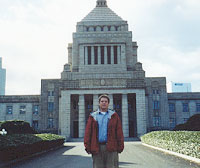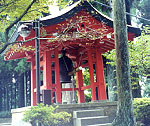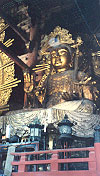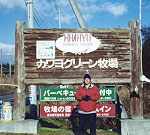by William J. Kawaihae ’04
 at right in front of the Japanese Diet (parliament) Building
at right in front of the Japanese Diet (parliament) Building
In the fall semester of 2002-2003, I participated in the Buddhist Studies in Japan program through Antioch College. I chose this program for many reasons: I have an interest in the Buddhist religion and Japanese culture and a desire to travel to Japan and see everything that the country has to offer. However, the main reason I participated was to make a connection with my ancestral Japanese roots.
First, I would like to tell students – if you are thinking about participating in this program – to make sure that you have an interest in learning about and practicing various forms of Buddhism, not just Zen. Also, you must be prepared to live in Buddhist temples and monasteries, be able to rise at 4:30 AM, to sleep on the floor, to eat only vegetarian food, and you should have an interest in learning about Japanese culture. If you have an adventuresome spirit, then this is the program for you.
 The program involved a great deal of traveling, with the other program participants and alone. There were three main temples where we stayed for up to three weeks while in Japan and various other places where we only visited for a night or two. During the extended stays, we studied the various form of Buddhism. The Antioch program begins in California at a place called Zen Mountain Center where we stayed for several days of orientation.
The program involved a great deal of traveling, with the other program participants and alone. There were three main temples where we stayed for up to three weeks while in Japan and various other places where we only visited for a night or two. During the extended stays, we studied the various form of Buddhism. The Antioch program begins in California at a place called Zen Mountain Center where we stayed for several days of orientation.  We learned temple etiquette, Japanese customs, basic meditation forms, and had a chance to learn about other people in the group. Then we were off to Japan for three months where we traveled to Kyoto, Koyasan, Nara, the island of Shikoku, Hiroshima, Sakamoto, Tokyo, and many small villages.
We learned temple etiquette, Japanese customs, basic meditation forms, and had a chance to learn about other people in the group. Then we were off to Japan for three months where we traveled to Kyoto, Koyasan, Nara, the island of Shikoku, Hiroshima, Sakamoto, Tokyo, and many small villages.
I found that many people had problems, in the beginning, with the food. It was strictly vegetarian, which means a lot of rice and tofu. Also, many of the group did not know how to use hoshi (chopsticks), which were the only eating utensils available. A basic meal would consist of rice, tofu and shoshu (soy sauce), miso soup, and some type of vegetable. For the most part, the food was good, and I learned to like Japanese food very much. However, if you did not like tofu, too bad because you had to get use to it! The sleeping arrangements were not that bad. Most of the time there would be two or three people in a room, but sometimes there would be up to six. The bedding consisted of a pillow filled with beans, a comforter, a sheet, and a futon; it actually was rather comfortable.
 The program had many highlights. My favorite experience was the Shikoku Pilgrimage, where we backpacked around the island of Shikoku hiking sometimes long distances to various temples. Another, highlight was going to Hiroshima for a few days. We visited the Peace Park, toured the museum, and talked with a survivor of the A-Bomb.
The program had many highlights. My favorite experience was the Shikoku Pilgrimage, where we backpacked around the island of Shikoku hiking sometimes long distances to various temples. Another, highlight was going to Hiroshima for a few days. We visited the Peace Park, toured the museum, and talked with a survivor of the A-Bomb.
 At the end of the program, we had a two-week research period. We each received a rail pass, which allowed us ride on all JR (Japan Rails) rail lines for free, so we had the opportunity to travel around Japan on our own. I traveled to Misawa, Kyoto, Tokyo and Kyushu on the Bullet Train. Leaving Japan, the group traveled to Hawaii where we completed our research and made individual presentations to the group.
At the end of the program, we had a two-week research period. We each received a rail pass, which allowed us ride on all JR (Japan Rails) rail lines for free, so we had the opportunity to travel around Japan on our own. I traveled to Misawa, Kyoto, Tokyo and Kyushu on the Bullet Train. Leaving Japan, the group traveled to Hawaii where we completed our research and made individual presentations to the group.
 In addition to the wonderful travel opportunities, the program offered many benefits, such as the Antioch leaders and teachers, fellow students, the monks, and the Japanese people as a whole. This was a great program to go on: an experience like no other, but it will only be memorable if you make the most of every situation. I would be glad to talk to any students interested in joining the Buddhist Studies Program in Japan in a future semester.
In addition to the wonderful travel opportunities, the program offered many benefits, such as the Antioch leaders and teachers, fellow students, the monks, and the Japanese people as a whole. This was a great program to go on: an experience like no other, but it will only be memorable if you make the most of every situation. I would be glad to talk to any students interested in joining the Buddhist Studies Program in Japan in a future semester.